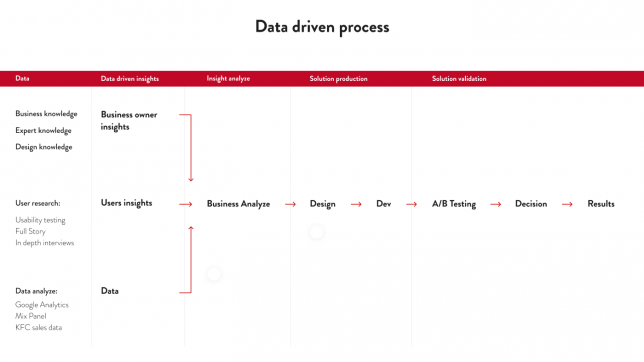
Łukasz Kowalski
-
May 12, 2022
-
7 min read
The ability to select the correct phases and tools in a UX process and arrange them in proper order constitutes a significantly important skill. It may seem obvious, but UX designers very often pay insufficient attention. When working on the most demanding digital projects in Poland and all over the world, I realised that the moment of building and explaining the process to the client constitutes the most crucial stage of each undertaking. In this text, I will explain my view on the essence of an individual approach to each process.
A mistake at the stage of designing a process will have much more severe consequences than any error in the design or code. Why is developing a process a challenging task? Because each project is different and always consists of many multi-layered variables: deadline, budget, significance for the organisation, client’s awareness, technology, availability of qualitative and quantitative data, organisation strategy, market competition, etc. There isn’t and cannot be one perfect process. An ideal (literature example) process would only happen in the case of no project limitations.
It is precisely a large number of significant variables, which results in that each process should be different and best adjusted to the partner’s business needs. The UX process should consist of many essential phases composed of various methods and tools, optimal and carefully adjusted to the project’s requirements. Designing a process often takes a few to even more than a dozen hours. And more precisely, in most cases, I reserve the right to apply changes in the process until finishing the discovery phase. Additional information and sources of knowledge, which may change a designer’s way of thinking about the process, appear especially during this phase. Most often, the case concerns selecting other workshop methods and leaving out specific – previously planned – tasks which turn out to be unnecessary or inefficient in light of new information.
![[final] 1_Flq_m74UbgEYoySyIWraCQ Flying Bisons' end-to-end process: Kickoff, Discovery, Strategy, Concept & Validation, Design, Development, and Optimization.](/uploads/media/x1328/08/608-1_Flq_m74UbgEYoySyIWraCQ.png?v=1-0)
Even though I believe in a flexible approach to a process, as UX designers, we should always start with communicating and explaining a literary process to the client. Educating business partners is partially our responsibility. By doing it, we begin to create the foundations of long-term cooperation, which should be the goal of each UX designer.
With an educated partner, working in the most efficient model is easier, meaning an evolutionary model based on qualitative and quantitative data.
![[final] 1_xMSsp-gt8RZPMsHNM87m1A A comparison of two graphs where y is website success and x is time. The Evolutionary Site Redesigns approach, where improvements are made constantly, is shown as better than Traditional Website Redesign, pointing to big gaps between redesigns and under-achievements of the product.](/uploads/media/x644/07/607-1_xMSsp-gt8RZPMsHNM87m1A.png?v=1-0)
Working in a data-driven process, in which KFC works regarding e-commerce, constitutes one of the most developing and engaging things I came across as a UX designer.

Designing a process is not everything
Properly designing a process constitutes just the beginning of the path. Several things have to be remembered.
1. The process has to be completely clear for the client.
Even the best thought-through and designed process won’t give the desired effect if the people we are supposed to execute it without completely understanding it. Each element of the process must be comprehensively explained and described - phase after phase, tool after tool, effect after effect.
- Why do we want to use specific tools and not other ones?
- Why do we want to carry out particular actions in a given order and not be arranged differently?
- Why do we need so much time for each phase of the project?
- Why do we have to meet 10 and not 5 times?
- Why do we need so many people for research?
- Etc.
The client should thoroughly understand this process. The best situation is when our business partner has the impression that they could design such a process! — “It’s so logical”. Achieving such an effect requires a well-prepared cause-and-effect sequence and much time devoted to presenting the process. However, from my experience, the time dedicated to explaining the process to a client constitutes one of the best investments in the project.
2. The client must not only accept it but also participate in it.
Compared to those which are more manageable, complex and demanding projects are often characterised by the fact that we need to gain industry knowledge as designers. Each well-designed process must include workshop elements during which we will gain the necessary knowledge from stakeholders in a systematised manner. Most things can be learned during a talk, but only workshop work allows for minimising the number of missed information. The process will only sometimes go as we plan. In my career, the most significant project problems, extensive projects, most often resulted from the need for more commitment on behalf of the people making decisions from the start of the project.
Encourage people making decisions to carry out workshops. Without them, projects extend and lose their value!
3. Only the client’s complete commitment to the process leads to the project’s success.
Our business partner is not only an expert in their field but also the person without whom the project won’t reach its end. A doctor may write a prescription, but the patient has to abide by the recommendations. Otherwise, the treatment won’t be successful. Constant and frequent communication, as well as engaging the client in the process, both constitute a recipe for success. The number of details we will miss in our daily work may be tremendous. Even the most diligently handled processes won’t last in the case of a lack of commitment.
- Technical limitations and possibilities
- Missing content
- Changing business decisions
- Lack of the client’s coherent vision
- Lack of determined business goals (KPI)
UX process versus the responsibility and risk
Currently, most companies know the importance of UX and why it is worth devoting much attention to it. Managers of large companies don’t have to be convinced about the profitability of investing in UX. Of course, this does not mean that companies precisely understand how to approach designing user experiences. The growing popularity of UX results in that a lot is often placed in the hands of people responsible for the user experience. Design teams often decide the future of the entire company or product. It is not a mistake, but all parties must be entirely aware. Our work relates to great responsibility, so one of our priorities should be the maximum risk reduction associated with executing a project.
Large and important projects are always related to risk. We made a mistake; something does not work, nobody uses the solution, we’ve spent much money, and we generally have nothing to show for it. Risk has to be managed. The UX process should be designed in such a way that the risk is minimised. The discovery phase is the primary and best tool for limiting the number of uncertainties.
The discovery phase constitutes each project's base, foundation, and cornerstone.
Properly planning and carrying out this phase allows, to a large degree, to limit the number of uncertainties, which has a proportional impact on the risk. The discovery phase stands for stitching up holes in the knowledge concerning the user and surroundings of the project or product. Special attention to this phase should be put in the case of highly innovative projects.
Each process of the discovery phase should be worked out up to the smallest detail, best even up to the date and team of a given workshop.
![[final] 1_CdGlSR04ZZkSySpxRJa9lw Schedule of Discovery Phase.](/uploads/media/x1328/09/609-1_CdGlSR04ZZkSySpxRJa9lw.png?v=1-0)
Of course, as I’ve already mentioned, I believe in a flexible process in which each element may be changed and take place sooner or later. The most important thing is constant control over the process and communicating changes to the client.
Summary
There is no perfect way to design the discovery phase. Designing this phase consists of profoundly understanding the client’s situation and business needs and selecting the best tools for their execution. I often take advantage of the “Design a better business” book, which includes many propositions of workshop frameworks.
- Carrying out a meeting for clarifying business goals/brief before we start designing the process of delivering the solution,
- Understanding, writing down, and communicating risks related to the project,
- Precisely defining and communicating gaps in qualitative and quantitative data and then preparing the process of acquiring missing data,
- Precise and detailed planning of the discovery phases,
- Direct and frequent contact with people making decisions,
- Learn about the mistakes of others: https://www.hownottolaunch.com/



















